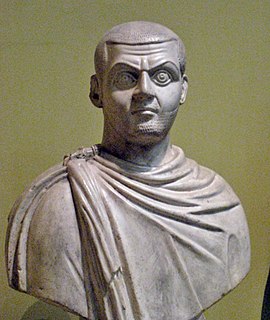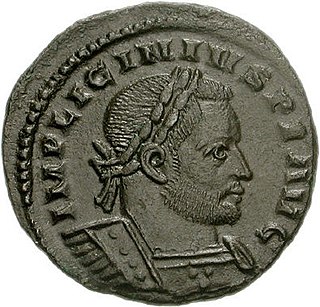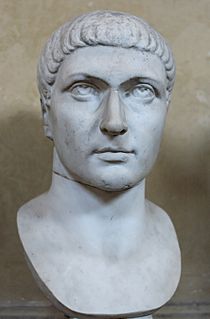Related Research Articles

Constantine I, also known as Constantine the Great, was Roman emperor from 306 to 337. Born in Naissus, Dacia Mediterranea, he was the son of Flavius Constantius. His mother, Helena, was Greek and of low birth. Constantine served with distinction under the Roman emperors Diocletian and Galerius. He began by campaigning in the eastern provinces before he was recalled in the west to fight along side his father in Britain. After his father's death in 306, Constantine became emperor; he was acclaimed by his army at Eboracum. He emerged victorious in the civil wars against emperors Maxentius and Licinius to become the sole ruler of the Roman Empire by 324.
Pope Miltiades, also known as Melchiades the African, was the bishop of Rome from 311 to his death on 10 or 11 January 314. It was during his pontificate that Emperor Constantine the Great issued the Edict of Milan (313), giving Christianity legal status within the Roman Empire. The pope also received the palace of Empress Fausta where the Lateran Palace, the papal seat and residence of the papal administration, would be built. At the Lateran Council, during the schism with the Church of Carthage, Miltiades condemned the rebaptism of apostatised bishops and priests, a teaching of Donatus Magnus.
The 310s decade ran from January 1, 310, to December 31, 319.

Year 313 (CCCXIII) was a common year starting on Thursday of the Julian calendar. At the time, it was known as the Year of the Consulship of Constantinus and Licinianus. The denomination 313 for this year has been used since the early medieval period, when the Anno Domini calendar era became the prevalent method in Europe for naming years. This year is notable for ending of the persecution of Christians in the Roman Empire.

Licinius was Roman emperor from 308 to 324. For most of his reign he was the colleague and rival of Constantine I, with whom he co-authored the Edict of Milan, AD 313, that granted official toleration to Christians in the Roman Empire. He was finally defeated at the Battle of Chrysopolis, and was later executed on the orders of Constantine I.

Galerius Valerius Maximinus, also known as Daza, was Roman emperor from 310 to 313. He became embroiled in the Civil wars of the Tetrarchy between rival claimants for control of the empire, in which he was defeated by Licinius. A committed pagan, he engaged in one of the last persecutions of Christians, before issuing an edict of tolerance near his death.

The Edict of Milan was the February AD 313 agreement to treat Christians benevolently within the Roman Empire. Western Roman Emperor Constantine I and Emperor Licinius, who controlled the Balkans, met in Mediolanum and, among other things, agreed to change policies towards Christians following the edict of toleration issued by Emperor Galerius two years earlier in Serdica. The Edict of Milan gave Christianity legal status and a reprieve from persecution but did not make it the state church of the Roman Empire. That occurred in AD 380 with the Edict of Thessalonica.
An edict of toleration is a declaration, made by a government or ruler, and states that members of a given religion will not be persecuted for engaging in their religious practices and traditions. The edict implies tacit acceptance of the religion rather than its endorsement by the ruling power.

Constantinian shift is used by some theologians and historians of antiquity to describe the political and theological changes that place during the 4th-century under the leadership of Emperor Constantine the Great. This theory holds that the shift or change began with the First Council of Nicaea. The term was popularized by the Mennonite theologian John H. Yoder.

During the reign of the Roman Emperor Constantine the Great (AD 306–337), Christianity began to transition to the dominant religion of the Roman Empire. Historians remain uncertain about Constantine's reasons for favoring Christianity, and theologians and historians have often argued about which form of early Christianity he subscribed to. There is no consensus among scholars as to whether he adopted his mother Helena's Christianity in his youth, or, as claimed by Eusebius of Caesarea, encouraged her to convert to the faith he had adopted himself.

As the Roman Republic, and later the Roman Empire, expanded, it came to include people from a variety of cultures, and religions. The worship of an ever increasing number of deities was tolerated and accepted. The government, and the Romans in general, tended to be tolerant towards most religions and religious practices. Some religions were banned for political reasons rather than dogmatic zeal, and other rites which involved human sacrifice were banned.

The Diocletianic or Great Persecution was the last and most severe persecution of Christians in the Roman Empire. In 303, the emperors Diocletian, Maximian, Galerius, and Constantius issued a series of edicts rescinding Christians' legal rights and demanding that they comply with traditional religious practices. Later edicts targeted the clergy and demanded universal sacrifice, ordering all inhabitants to sacrifice to the gods. The persecution varied in intensity across the empire—weakest in Gaul and Britain, where only the first edict was applied, and strongest in the Eastern provinces. Persecutory laws were nullified by different emperors at different times, but Constantine and Licinius' Edict of Milan (313) has traditionally marked the end of the persecution.

The persecution of Christians occurred, sporadically and usually locally, throughout the Roman Empire, beginning in the 1st century AD and ending in the 4th century AD. Originally a polytheistic empire in the traditions of Roman paganism and the Hellenistic religion, as Christianity spread through the empire, it came into ideological conflict with the imperial cult of ancient Rome. Pagan practices such as making sacrifices to the deified emperors or other gods were abhorrent to Christians as their beliefs prohibited idolatry. The state and other members of civic society punished Christians for treason, various rumored crimes, illegal assembly, and for introducing an alien cult that led to Roman apostasy.

Christianity began as a Second Temple Judaic sect in the 1st century in the Roman province of Judea, from where it spread throughout and beyond the Roman Empire.

Christianity in the 4th century was dominated in its early stage by Constantine the Great and the First Council of Nicaea of 325, which was the beginning of the period of the First seven Ecumenical Councils (325–787), and in its late stage by the Edict of Thessalonica of 380, which made Nicene Christianity the state church of the Roman Empire.
The Civil Wars of the Tetrarchy were a series of conflicts between the co-emperors of the Roman Empire, starting in 306 AD with the usurpation of Maxentius and the defeat of Severus and ending with the defeat of Licinius at the hands of Constantine I in 324 AD.

Early Christian churches in Milan are the first churches built immediately after the Edict of Milan in February 313, issued by Constantine the Great and Licinius, which granted tolerance and religious liberty to Christianity within the Roman Empire.

Persecution of pagans in the late Roman Empire began during the reign of Constantine the Great (306–337) in the military colony of Aelia Capitolina (Jerusalem), when he destroyed a pagan temple for the purpose of constructing a Christian church. Christian historians alleged that Hadrian had constructed a temple to Aphrodite on the site of the crucifixion of Jesus on Golgotha hill in order to suppress Jewish Christian veneration there. Constantine used that to justify the temple's destruction, saying he was simply reclaiming the property.

The Religious policies of Constantine the great have been called "ambiguous and elusive." Born in 273 during the Crisis of the Third Century, he was thirty at the time of the Great Persecution, saw his father become Augustus of the West and then shortly die, spent his life in the military warring with much of his extended family, and converted to Christianity sometime around 40 years of age. His religious policies, formed from these experiences, comprised increasing toleration of Christianity, limited regulations against Roman polytheism with toleration, participation in resolving religious disputes such as schism with the Donatists, and the calling of councils including the Council of Nicaea concerning Arianism. John Kaye characterizes the conversion of Constantine, and the council of Nicea that Constantine called, as two of the most important things to ever happen to the Christian church.

In the history of the Roman Empire, the "Little Peace of the Church" was a roughly 40-year period in the latter 3rd century when Christianity flourished without official suppression from the central government. It is particularly associated with the reign of Gallienus (253–268), who issued the first official declaration of tolerance regarding Christians. Among the series of imperial edicts that halted acts of persecution against Christians, one addressed to the bishops of Egypt has survived, recognizing places of worship and cemeteries as ecclesiastical property and restoring them to Christian ownership. The Church for the first time even asked a Roman emperor to arbitrate an internal dispute. In 272, after Paul of Samosata was accused of heresy but refused to be deposed as bishop of Antioch, Aurelian ruled in favor of his successor, who was in good standing with the church hierarchy.
References
- ↑ For an overview of the representation of Roman religion in early Christian authors, see R.P.C. Hanson, "The Christian Attitude to Pagan Religions up to the Time of Constantine the Great" and Carlos A. Contreras, "Christian Views of Paganism" in Aufstieg und Niedergang der römischen Welt II.23.1 (1980) 871–1022.
- ↑ Historians debate whether or not the Roman government distinguished between Christians and Jews prior to Nerva's modification of the Fiscus Judaicus in 96. From then on, practising Jews paid the tax, Christians did not. Dunn, James D.G., Jews and Christians: The Parting of the Ways, A.D. 70 to 135, Wm. B. Eerdmans Publishing (1999), ISBN 0-8028-4498-7, Pp 33-34.; Boatwright, Mary Taliaferro & Gargola, Daniel J & Talbert, Richard John Alexander, The Romans: From Village to Empire, Oxford University Press (2004), ISBN 0-19-511875-8, p. 426.;
- ↑ Wylen, Stephen M., The Jews in the Time of Jesus: An Introduction, Paulist Press (1995), ISBN 0-8091-3610-4, Pp 190-192.
- ↑ Sullivan, Andrew (Jan 14, 2001). "Christianity's Original Sin".
According to the author, the relationship with the Jews is the central issue in the history of the church
 This article incorporates text from a publication now in the public domain : Herbermann, Charles, ed. (1913). "Peace of the Church". Catholic Encyclopedia . New York: Robert Appleton Company.
This article incorporates text from a publication now in the public domain : Herbermann, Charles, ed. (1913). "Peace of the Church". Catholic Encyclopedia . New York: Robert Appleton Company.